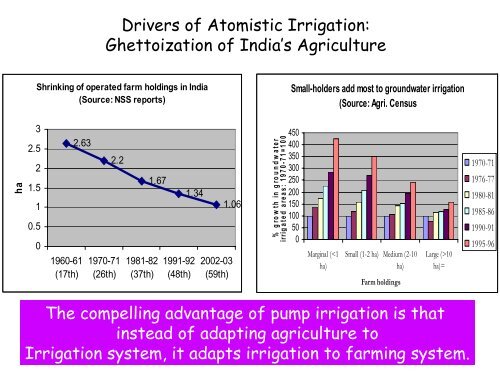Indian Irrigation in Transition - Tushaar Shah
Indian Irrigation in Transition - Tushaar Shah
Indian Irrigation in Transition - Tushaar Shah
Create successful ePaper yourself
Turn your PDF publications into a flip-book with our unique Google optimized e-Paper software.
ha<br />
Drivers of Atomistic <strong>Irrigation</strong>:<br />
Ghettoization of India’s Agriculture<br />
Shr<strong>in</strong>k<strong>in</strong>g of operated farm hold<strong>in</strong>gs <strong>in</strong> India<br />
(Source: NSS reports)<br />
3<br />
2.5<br />
2<br />
1.5<br />
1<br />
0.5<br />
0<br />
2.63<br />
1960-61<br />
(17th)<br />
2.2<br />
1970-71<br />
(26th)<br />
1.67<br />
1981-82<br />
(37th)<br />
1.34<br />
1991-92<br />
(48th)<br />
1.06<br />
2002-03<br />
(59th)<br />
% growth <strong>in</strong> groundwater<br />
irrig ated areas: 1970-71=100<br />
Small-holders add most to groundwater irrigation<br />
(Source: Agri. Census<br />
450<br />
400<br />
350<br />
300<br />
250<br />
200<br />
150<br />
100<br />
50<br />
0<br />
Marg<strong>in</strong>al (10<br />
ha)=<br />
The compell<strong>in</strong>g advantage of pump irrigation is that<br />
<strong>in</strong>stead of adapt<strong>in</strong>g agriculture to<br />
<strong>Irrigation</strong> system, it adapts irrigation to farm<strong>in</strong>g system.<br />
1970-71<br />
1976-77<br />
1980-81<br />
1985-86<br />
1990-91<br />
1995-96

















